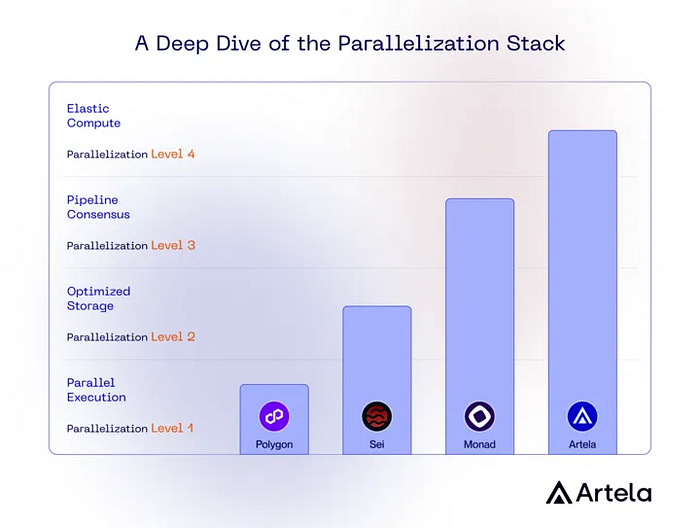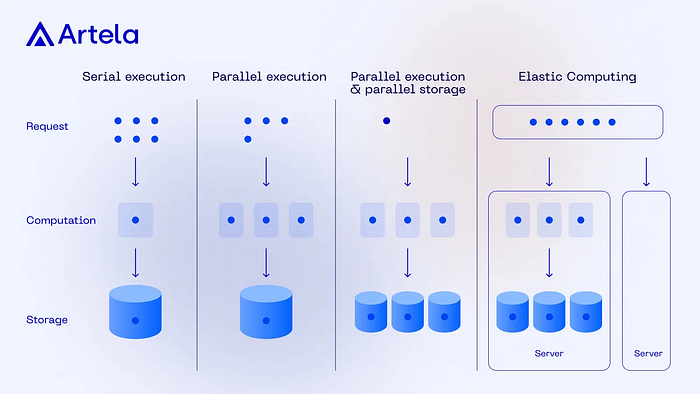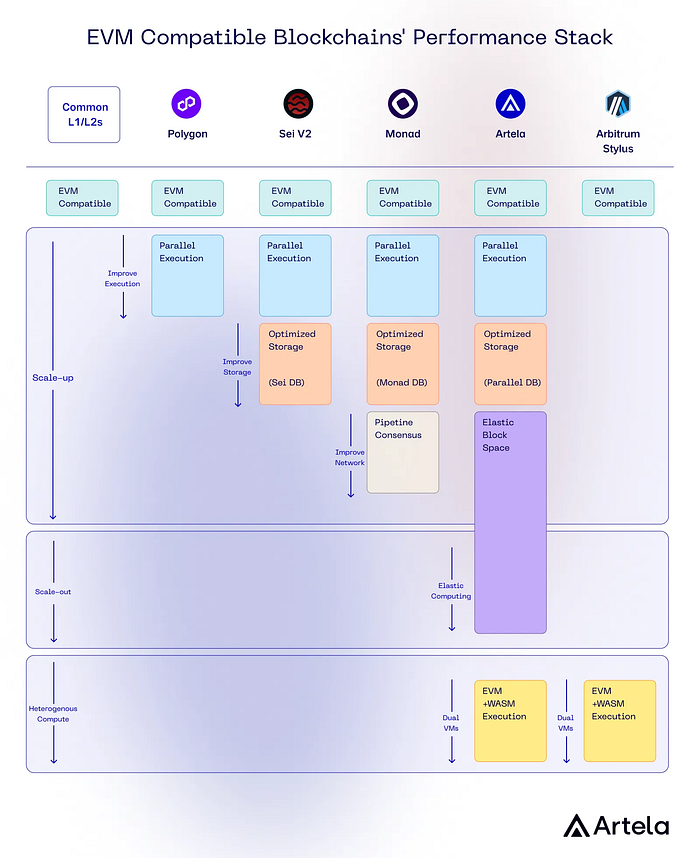Author: Artela Chinese Blog
How deep is your understanding of "Parallel EVM"? What changes do various components of the blockchain need to make for transactions to be executed in parallel? If we were to categorize the levels of parallelization, what tiers would there be? Do new directions like PayFi need to be equipped with this new engine?
This article will introduce some in-depth concepts of Parallel EVM, explore the extreme innovations behind Parallel EVM, and discuss the ongoing development and prospects of technology and scenarios.
Non-Technical Understanding of Parallel EVM
When the EVM executes a block, the transactions within the block can only line up in a single queue, waiting to be processed one by one. In contrast, Parallel EVM can arrange the transactions in the block into multiple queues, allowing them to wait for execution in parallel, thus enabling the block to be executed more quickly.
Breaking a single queue into multiple queues, this method seems simple, but achieving it is not an easy task. Even if you run a fast-food restaurant: opening multiple ordering windows can create multiple queues. However, the trouble that comes with it is: can the kitchen staff keep up with the order volume? Even if you increase the number of chefs, there are still further difficulties due to limited kitchen space and equipment.
Ultimately, you can see that a fast-food restaurant with higher throughput often needs to introduce highly automated equipment to achieve this. What seems like a simple act of opening a few more ordering windows requires millions of dollars in investment in automated equipment to make it meaningful.
EVM Parallelization Levels
Similar to running a restaurant, Parallel EVM is easy to understand on the surface, but a deeper look reveals that all components of the blockchain need to cooperate and be transformed to achieve the high-performance effects brought by parallel execution. Making EVM parallel is not just about solving a single point problem; it involves addressing a series of interconnected technical issues that need to be optimized from the surface to the core.
Here we use the concept of "parallelization levels" to review the optimization depth of different Parallel EVM projects.

Level 1 — Parallelizing Execution
Grouping the transactions in a block so that they can be executed in parallel by the EVM, while ensuring that the execution results are consistent with those of the original serial execution. This feature is the most basic implementation of Parallel EVM, enhancing the execution speed of blocks.
As a pioneering project exploring Parallel EVM, Polygon PoS and BNB Chain have attempted to introduce parallel execution to improve performance on running blockchains. However, since they are operating blockchains, it is difficult to achieve comprehensive optimization of all components, typically only achieving this level of parallelism.
Level 2 — Optimizing Storage
After the EVM completes the execution of transactions, it needs to update data storage. Therefore, after parallel execution, the efficiency of data updates also needs to be improved; otherwise, storage will become a new bottleneck. This feature elevates Parallel EVM to a new level, improving not only execution speed but also storage efficiency.
New L1 public chains like Sei, Monad, and Artela, unlike Polygon PoS, do not have historical burdens and are designed around parallelization, thus focusing on optimizing storage levels. For example, Sei DB, Monad DB, and Artela’s Parallel Storage are all high-performance storage solutions designed for parallelization.
Level 3 — Pipelining Consensus
When execution and storage are no longer bottlenecks, it becomes possible to require blocks to package more transactions more quickly, which involves improvements to consensus algorithms. This level can further enhance the overall transaction throughput of the blockchain.
One of Monad's innovations is deferred-execution, which separates execution from the consensus process, allowing the consensus process to focus on the data of the block rather than execution, thus achieving higher throughput consensus. Artela's elastic block space allows the size of blocks in the consensus process to be flexibly scaled.
Level 4 — Elastic Computing
When consensus, execution, and storage are all parallelized, the blockchain can enter the next stage: achieving elastic characteristics similar to the cloud.
On the basis of full-stack parallelization, Artela has implemented "elastic block space," which, like the cloud, allows the network to flexibly expand the processing power required based on the demands of dApp subscriptions. This may represent the ultimate level of parallelization. After dApps enjoy elastic block space, they have predictable performance, ensuring stability in large-scale adoption scenarios aimed at consumers.
We can further understand these four levels of parallelization through Artela's technical diagram, which resembles the evolutionary path of traditional high-performance servers, evolving from a single server to read-write separation, and then to elastic expansion of both reads and writes.

How Will EVM Parallelization Evolve?
From the parallelization levels above, it can be seen that Parallel EVM is actually superficial; the deeper the optimization goes, the more it optimizes other non-EVM components of the blockchain. The core behind high-performance and scalable blockchain technology is the underlying kernel. The high performance of EVM public chains revolves around extreme innovations compatible with EVM.
Is there an endpoint to the performance optimization of blockchains based on Parallel EVM? We can glean some insights from the development history of Web2 server technology.
With the gradual advancement of large-scale applications, the development of Web2 server technology has gone through several stages:
- Single Machine Architecture: Early servers relied on a single physical device, lacking flexible scalability and limited in performance.
- Scale-up: Upgrading hardware (such as stronger CPUs and memory) to enhance the performance of a single server, but single-machine scaling has obvious bottlenecks.
- Scale-out: In the era of cloud computing, increasing servers and forming clusters to achieve horizontal scaling of computing power, breaking through the performance limitations of a single machine.
- Heterogeneous Computing: With the surge in AI demand, utilizing heterogeneous computing resources like GPUs and TPUs to improve processing capabilities for AI and deep learning tasks, meeting the demand for high-performance computing power.
If we place the latest high-performance computing of blockchains on the same chart, we can see a technology architecture with future imagination.

New blockchains without historical burdens, such as Sei and Monad, are achieving extreme scale-up through Parallel EVM, while Artela, based on parallelization, is providing predictable performance through scale-out. In addition to Parallel EVM, Dual VMs solutions are also being adopted, with Arbitrum and Artela incorporating WASM as heterogeneous computing into the blockchain architecture, further supplementing the shortcomings of EVM.
The Significance of Enhancing EVM Parallelization Levels
Returning to the restaurant example, a modern semi-automated high-efficiency kitchen is not suitable for all restaurants, but it can open up the fast-food market. Existing classic DeFi protocols may operate well on any infrastructure; they seem to have little need for the support of a parallelization engine. However, the crypto industry is in a phase of shifting towards value realization, and some new protocols now have a foundation to try.
PayFi is a culmination of crypto assets, stablecoins, payments, and DeFi, representing an innovative application model that combines payment functions with financial services. Through PayFi, blockchain payment systems will truly unleash their potential, promising to create a more liquid and adaptable global financial market. Having fast settlement capabilities, low transaction fees, and a strong developer ecosystem are important conditions for realizing PayFi. Compared to non-EVM high-performance public chains, Parallel EVM has the unique advantage of being compatible with a large existing ecosystem infrastructure. The EVM ecosystem has the strongest TLV, developers, and mature stacks, and Parallel EVM continues to provide fast settlement capabilities and low transaction fees, making it the best incubator for PayFi.
The article by Reforge Research, "Death, Taxes, and EVM Parallelization", summarizes the insightful views of major participants in Parallel EVM, and some new DeFi directions have become possible: programmable central limit order books (pCLOB) now have a feasible foundation. By leveraging the high performance and high parallel processing capabilities provided by Parallel EVM, pCLOB can achieve complex and efficient trading functions similar to traditional financial trading platforms in a decentralized environment. It allows developers to embed custom smart contract logic during the order submission and execution process, which can be used for additional validation, determining execution conditions, and dynamically adjusting transaction fees, providing greater flexibility and security, and supporting more complex trading strategies and financial products.
The consumer narrative began to be discussed during Singapore's 2024 Token2049, where we saw many consumer-oriented projects: for example, Morph launched a consumer-level L2 with the slogan "A Global Consumer Layer," aiming to bring the value of Web3 into daily life, breaking the curse of "public chain ghost towns" and false TVL prosperity; or purely to C projects like Matr1x Fire and Shrapnel, which are hardcore FPS games that have gameplay experiences not much different from traditional FPS games. These projects have found good angles to push crypto further into the mainstream. Compared to past DeFi and NFT dApps, their common characteristic is the need for large-scale applications, which places higher demands on infrastructure. The Parallel EVM infrastructure can serve as a solid foundation for this.
If all these new directions open up the market, the parallelization capabilities of EVM will become a long-term project of continuous optimization and breakthroughs, akin to cloud computing facilities.
Conclusion
Parallel EVM is merely a summary of high-performance EVM; on the surface, it is the parallel execution of EVM transactions, but in reality, "pulling one thread affects the whole" — it requires deep optimization of technical components behind it. We use parallelization levels to summarize different degrees of implementation. The infrastructure is unlocking consumer scenario use cases, and the advantages of Parallel EVM are expected to elevate the past ecological accumulation to a new level.
免责声明:本文章仅代表作者个人观点,不代表本平台的立场和观点。本文章仅供信息分享,不构成对任何人的任何投资建议。用户与作者之间的任何争议,与本平台无关。如网页中刊载的文章或图片涉及侵权,请提供相关的权利证明和身份证明发送邮件到support@aicoin.com,本平台相关工作人员将会进行核查。




